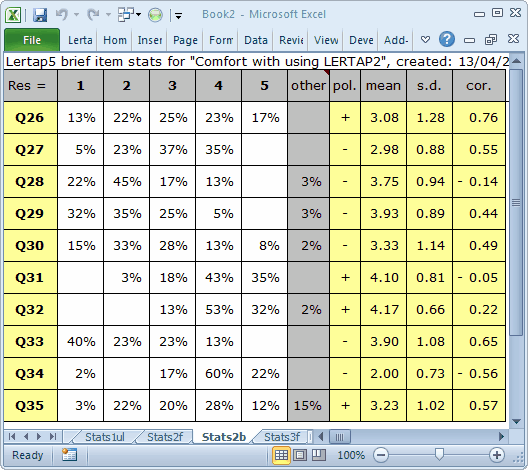Brief statistics (affective)
Have a squiz—here are the brief results for the “Comfort” affective subtest (or “scale”—a collection of related affective items is often referred to as a scale):

The Stats2b worksheet shown above has its row and column headers hidden at Lertap’s request—you can turn them back on easily.
The first row of the Stats2b report includes the subtest’s name, “Comfort with using LERTAP2”. Where did this name come from? From the subtest’s *sub card, or line, in the CCs worksheet.
The response codes used by the subtest’s items are shown to the right of the Res = cell, in the second row. This affective subtest used the default response code set of Res=(1,2,3,4,5). If you now were to refer back to the listing of CCs lines, you might wonder why the first subtest, Knwldge, has an explicit Res=() declaration on its *sub card, whereas Comfort does not. The answer has to do with the fact that the Comfort scale used default response codes—Knwldge did not.
Looking at the results for Q26, 13% of the respondents opted for the first response, 22% for the second, and so forth. All respondents answered Q26, a fact which is revealed by the absence of an entry under the “other” column. When there’s no response to an item, or an invalid response, Lertap lets you know by putting something in the “other” column.
Q26’s “pol.” is “+”. What’s this mean? It means that positive scoring applies to Q26, or, in other words, that the scoring for this item has not been reversed. If you’re itching to know more about scoring, hang on—it’s coming—there’s more about it in the next section.
The average of the Q26 responses, and their standard deviation, are found under the “mean” and “s.d.” columns, respectively. The “cor.” column gives the value of the Pearson product-moment correlation coefficient between the item and the criterion score. At this point the criterion score is the sum of each person’s responses to the other items on the subtest, that is, the subtest score less Q26. Why exclude Q26 from the subtest score? So that the effects of part-whole inflation are eliminated—the correlation between an item and the subtest score will be inflated if the item is part of the subtest score, and, to control for this, Lertap applies a correction.
More information about this subtest’s items is to be found in the “full” statistics report, Stats2f in this case. Next?
